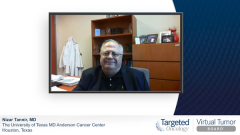
Frontline Therapy in Advanced Clear Cell RCC: The CLEAR Trial
Scott Tykodi, MD, PhD, reviews data from the CLEAR trial investigating 2 IO combination therapies for advanced renal cell carcinoma treatment.
Episodes in this series

Nizar Tannir, MD: I’m going to turn it over to you, Scott. Take us through the CLEAR study and its results. Then we’ll have another pause to have some questions and discussion about the CLEAR study. You participate in the CheckMate 214 trial as well, so you can take us through the data from CheckMate 214. Scott, to you.
Scott Tykodi, MD, PhD: Thank you, Nizar. In our case, we talked about starting frontline therapy with lenvatinib-pembrolizumab. That’s based on the trial schematic from the CLEAR trial. This was a frontline clinical study, so patients couldn’t have prior therapy. Enrollments were limited to only clear cell histology, so the data are limited to that subset of our patients. [Key eligibility criteria] included good performance status, measurable disease, and good organ function.
This was a 3-arm study. There were 2 investigational arms. The star of the show is the IO [immunotherapy] combination that led to FDA approval, but there was also a targeted arm. The investigational arms were lenvatinib starting at 20 mg daily, with pembrolizumab given in a conventional fashion, or lenvatinib 18 mg plus everolimus at 5 mg, which is already an approved regimen but only in patients with prior therapy. We’re now exploring that doublet in the frontline setting. The comparison arm for both of the investigational arms was sunitinib delivered in a conventional way. Most people are familiar with 50 mg daily and a schedule of 4 weeks on, 2 weeks off. The primary end point for this study was progression-free survival. The secondary end points were overall survival, overall response rate were, safety, and quality of life. An exploratory analysis [looked at] duration of response and biomarker studies.
Not surprisingly, the baseline characteristics [of this] randomized, large study were very balanced. Nothing stands out as being highly discordant between groups. In the left column are the different clinical categories shown by age, geographic region, Memorial Sloan Kettering Cancer Center or IMDC [International Metastatic Renal Cell Carcinoma Database Consortium] risk group, presence of sarcomatoid features, PD-L1 expression in the tumor, and history of prior nephrectomy. These are very nicely balanced groups throughout.
The primary end point was progression-free survival. The high-level data of lenvatinib-pembrolizumab, the IO-containing arm, showed a median progression-free survival of 23.9 months. The frontline doublet targeted arm, lenvatinib-everolimus, was 14.7 months, and then sunitinib was 9.2 months. The hazard ratio is in the right-hand column . The IO-containing regimen had a hazard ratio of 0.39 in comparison with the sunitinib control arm.
Looking at overall survival in the same sequence, lenvatinib-pembrolizumab, we don’t yet have a median survival end point. But by landmark analysis, the hazard ratio favors the IO combination at 0.66 and a positive P value. [A median overall survival end point was] not reached by either of the other 2 arms, lenvatinib-everolimus or sunitinib, with the follow-up that has been conducted so far. The overall survival hazard ratio is slightly inferior for lenvatinib-everolimus to sunitinib at 1.15.
The overall response rates are shown here. It’s a little busy, but let’s tease out a couple of points. Across the top line and shown in the red box, we see the aggregate overall response rate. Lenvatinib-pembrolizumab had a 71% objective response rate. That’s the high-water mark in the frontline space for metastatic renal cell carcinoma. The targeted combination, lenvatinib-everolimus, was also fairly robust, with a 53.5% response rate. Sunitinib, as you’d expect in the frontline setting, had a 36.1% response rate.
If we go back to lenvatinib-pembrolizumab and break out the responses, the complete response rate was 16%, which has drawn a lot of attention. That’s the best complete response rate of any of our frontline combination regimens. [Then there’s] partial response, stable disease, and progressive disease. Primary progression or primary refractory disease was the end point for only 5.4% of patients. That’s something we talked about in terms of our case presentation that’s sometimes a discriminator when selecting regimens.
Lenvatinib-everolimus and sunitinib had complete response profiles less than the IO-containing regimen. Primary progressive disease was 7.3% for the targeted therapy combination and 14% for sunitinib. As Nizar mentioned, that tends to be a fairly consistent finding for sunitinib, which is in the low teens across most of our studies. Shown at the bottom is the relative response profile of our combinations vs the sunitinib comparison. It’s better, with a positive P value for both investigational arms.
One of the exploratory end points was duration of response. Lenvatinib-pembrolizumab was 25.8 months, besting a 2-year total duration of response in the response cohort. Lenvatinib-everolimus wasn’t quite as good, at 16.6 months, and the comparator standard of care sunitinib was 14.6 months. Then shown here is a rostering out of adverse effects. Of course, the flip side of our cancer efficacy is the tolerability of our regimen. The take-home message from this study is that you see the adverse affects you expect from each drug class, but there was no unexpected or surprising adverse effect that was in some way a synergistic toxicity of the drug combination. The high-grade toxicity is greater than grade 3 for the IO-TKI [tyrosine kinase inhibitor] combination.
What jumps out is hypertension, which is a well-recognized adverse effect of the TKI component, 4% hand-foot syndrome, and 7% proteinuria. Sunitinib’s [toxicity] is conventional for that drug class. Hypertension is the most common adverse effect for sunitinib. The take-home [message] was that there were no surprises but just to be familiar with what you expect to see from each of the drugs applied, and driving defensively with your patients as you follow them in the clinic.
Transcript edited for clarity.










































